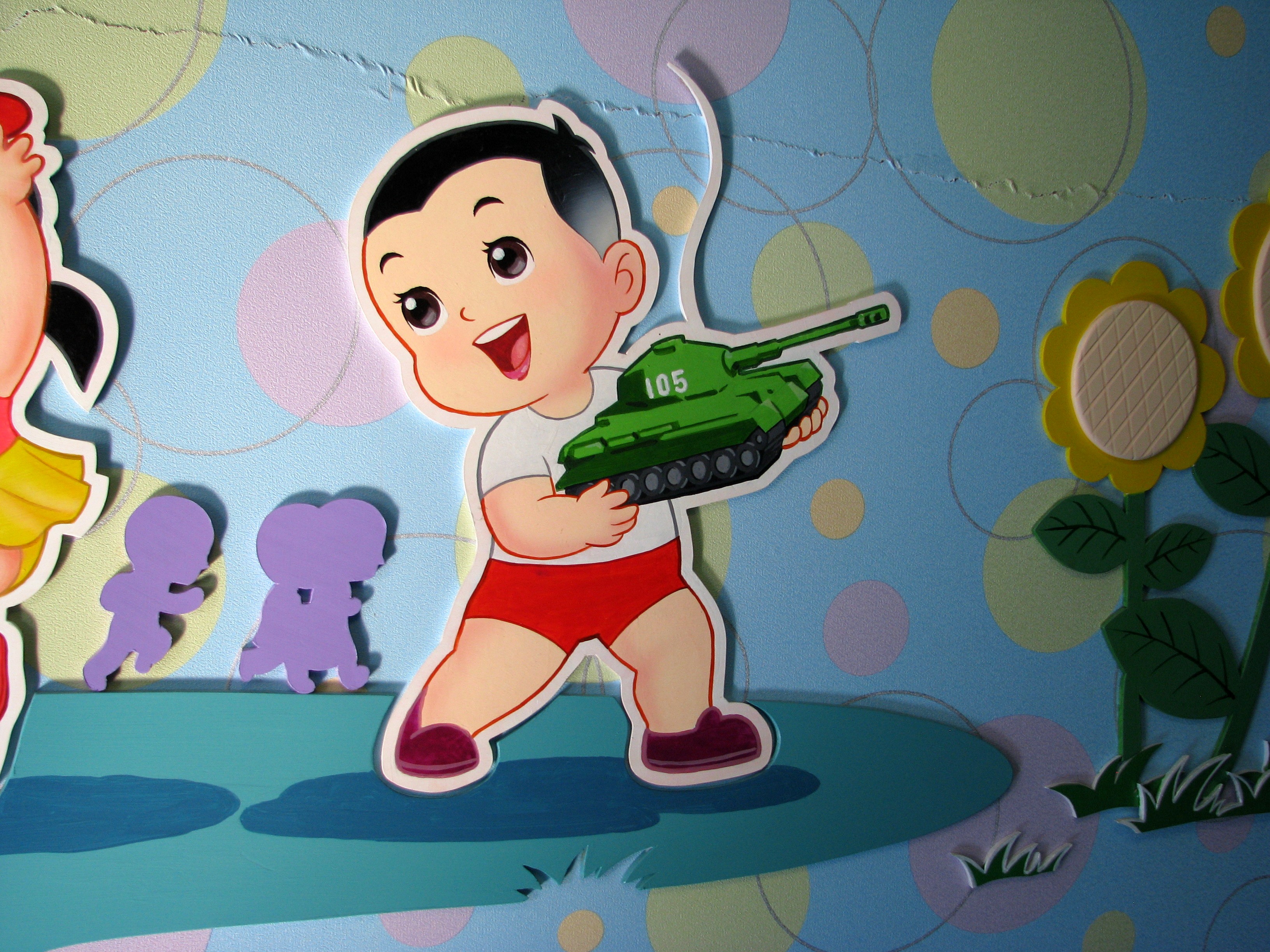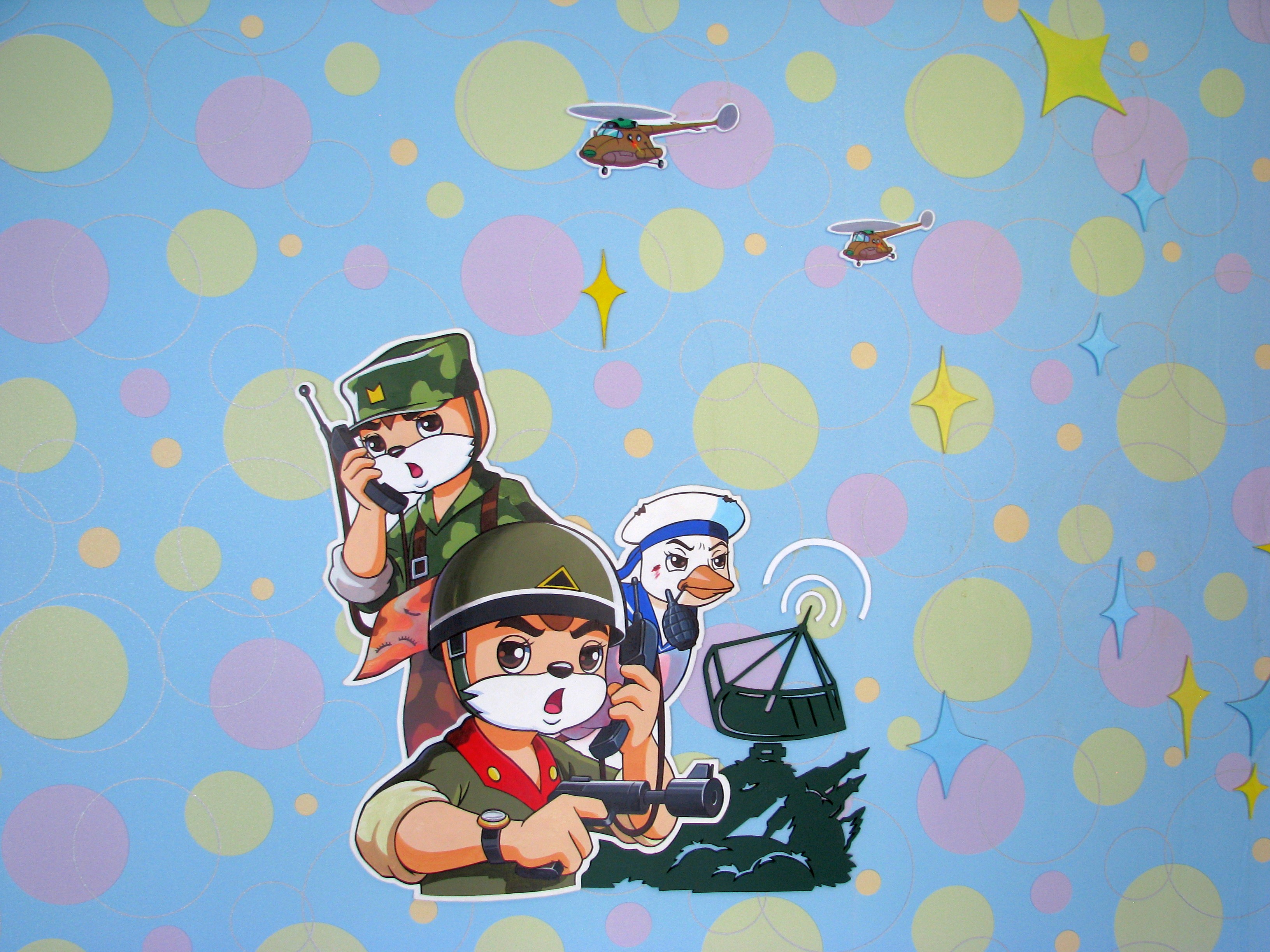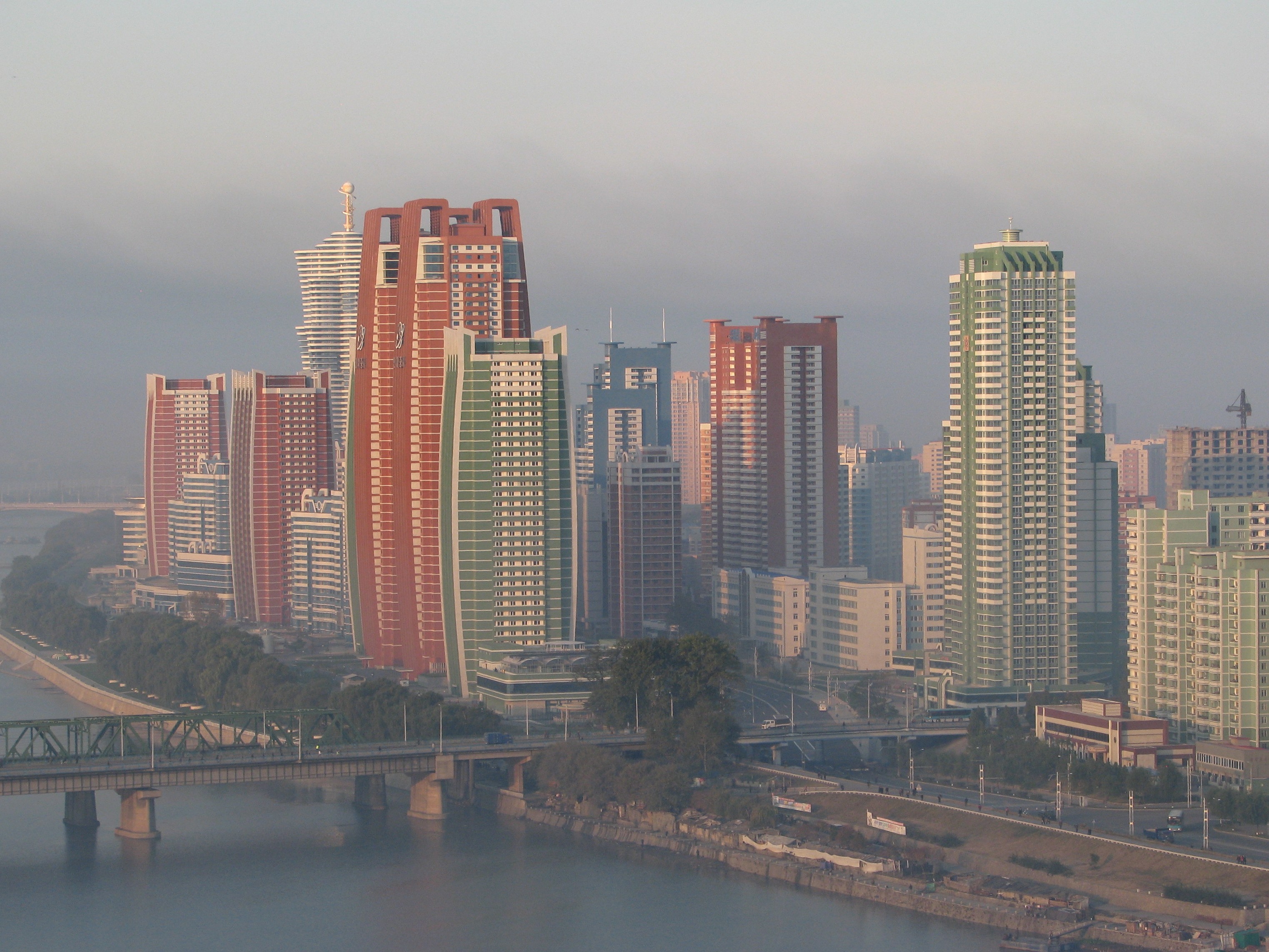The Long Road to Reconciliation: Reflections on a Visit to the Sinchon Museum
A light drizzle painted our windshield, sparkling like tiny diamonds in the reflected headlights of our minibus. Night had fallen rather suddenly as we made our way back to our Pyongyang hotel along country roads, now about an hour and a half away. The twelve members of our World Council of Churches (WCC) delegation and our Korean Christian Federation (KCF) hosts had fallen into an uncharacteristic silence as our bus swayed to and fro, avoiding potholes, bicycles and pedestrians on their way home from work.
It had been a long day since we started our journey south on the Unification Highway toward the absurdly named “demilitarized zone.” The military officer who acted as our tour guide had started his scripted introduction to the site with appropriate solemnity, but he soon lightened up amid the friendly chatter of our South Korean colleagues from the National Council of Churches in Korea (NCCK).
The officer had led us to the location where the Korean Armistice Agreement was signed 62 years ago and allowed us to include him in group pictures. The DPRK’s obligatory propaganda at the Joint Security Area had been sparse and to the point, contributing to a sober ambiance disturbed only by the excited banter of first-time visitors. As we pointed our cameras toward the southern end of the blue UN barracks, the area had seemed deserted; there was not a single South Korean soldier or tourist to be seen. In this quiescent atmosphere, the oft-repeated claim that the DMZ is “the most dangerous place on earth” had seemed almost farcical.
Following a traditional meal served in dozens of shiny brass bowls at the National Folk-Custom Hotel in the picturesque Kaesong city, we returned north by bus. As riders chatted, some compared our visit to equivalent trips taken from the southern side of the border. The South Korean DMZ tour, which I have taken numerous times, has in recent years turned into a sort of politicized Disneyland, complete with souvenir shops and carnival rides for children.
Some members of our group dozed off as our bus rumbled along its now-familiar trajectory. Only one item remained on the day’s printed itinerary, reading simply: “Sinchon Museum.” We had no inkling what sort of museum this might be. Well, that’s not entirely accurate. I did have an inkling. In fact, I had a strong suspicion. But I never could have imagined what I would experience there.
As we arrived at our destination, we were told to “act in a solemn manner”—no joking or laughing, in other words. But that demand revealed little about the location, since we had been given the same directive several times before. After arriving at the new Sunan International Airport, we were asked to act in a solemn manner as we passed giant statues of Kim the father and Kim the son. That didn’t prevent me from remarking on Kim Il Sung’s transformation in this new rendition: a toothy smile remade the stern face I had known for some 25 years, and his familiar Mao suit had morphed into a Western suit and tie. Even Kim Jong Il, who rarely smiled in the photographs displayed wherever we went, grinned in this sculptural portrayal as though he were sharing an inside joke with his father.
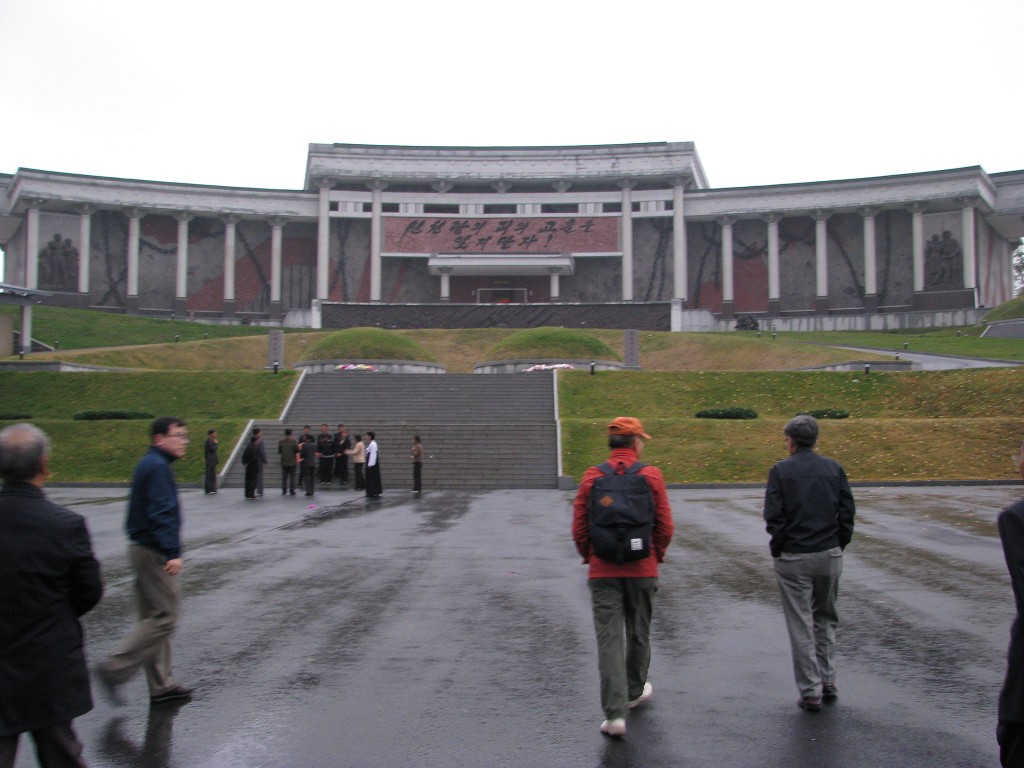
Calls for solemnity hadn’t prevented some in our group from flirting with the attractive tour guide during our earlier visit to the Mangyongdae “native home” of the Great Leader. The inexperienced KCF interpreter who accompanied us throughout the week had instructed us on the manner of “paying tribute.” I had suggested to our young colleague that a better wording might be to “pay respect.” Does paying respect mean bowing, she wanted to know. The difference in nuance between “tribute” and “respect” was less important to her than the ability to convey practical guidance regarding expected behavior.[1]
But for all the advertent and inadvertent ways I allowed myself to feign respect and admiration, the Sinchon Museum turned out to be in a class by itself. As we approached the museum through the rainy night, it was not the day’s fatigue that rendered us silent. It has been 20 years since the start of serious humanitarian engagement. Since we were here at the invitation of KCF, our visit was meant to promote international solidarity for peace and reconciliation in Korea, and thereby also to strengthen and support local Christians. (Yes, Virginia, there are Christians in the DPRK!) Highlights of our visit included:
- Visits to KCF institutions like their theological seminary and social service bread factory;
- Worshipping at the newly rebuilt Bongsu and Chilgol churches (both of which feature prominently on the new Pyongyang city maps), and a typical house church;
- Participating in the first ecumenical consultation on the Korean peninsula with both the North Korean KCF and the South Korean NCCK; and
- Joining a courtesy call on Kim Yong Dae, Vice President of the Supreme People’s Assembly, that turned into an hour-long substantive conversation.
I was also amazed by the rapid changes in Pyongyang itself: the proliferation of small box-like shops and fast food outlets on every major street of the city; never-before-encountered traffic jams, dotted with multi-colored taxis belonging to six different taxi companies; the ubiquity of smartphones in the hands of ordinary citizens; privately owned solar panels attached to apartment windows and balconies; and the obvious rise of a middle class able to afford these improvements in their lives.
All these developments at first seemed to suggest a country growing more like its neighbor to the south. Yet on the day we left Pyongyang, the DPRK media announced that a Congress of the Workers’ Party of Korea would be held in early May 2016—the first in 36 years. If this announcement was yet another sign of the regime’s stability in the midst of such rapid domestic change, what could it portend for the DPRK’s future place in the world?
In our talks with officials and academics, one theme continued to impose itself: seventy years have passed since the Korean peninsula’s liberation and division, and it is now high time to seriously engage in peace efforts. Although there is still a lot of lip service paid to the notion of reunification, I felt this time that the reduction of tensions held a higher priority. Even the way reunification is described by North Koreans sounds more like peaceful coexistence than any German-style absorption of one by the other.
“Nuclear powers have a responsibility to reduce tensions, because an outbreak of war is unthinkable,” said Park Yong Chol, Vice President of the DPRK’s Institute for Research Into National Reunification. “We take this responsibility seriously. We wish the US would do the same.”
I had once been ready to give Park the benefit of my doubt. But when I reached the final stop on our itinerary—enveloped by darkness, rain and the silence of my traveling companions—I found my optimistic nature assaulted by a savage skepticism.
The Sinchon Museum of American Atrocities is a memorial dedicated to what North Korea claims are the 35,000 victims of an American massacre during the Korean War. The Kim Jong Un regime completely rebuilt and redesigned the museum in one of its many beautification projects. While the old site housed exhibits of photographs, documents and paintings, the new museum, inaugurated in June of this year, has life-sized, detailed representations in sculpture and three-dimensional scenery of uninhibited violence being perpetrated by American soldiers, with sneering—presumably South Korean—collaborators looking on. As visitors move between scenes, each complemented by screaming sound effects, their senses are assaulted by what I can only describe as a pornography of violence: women having spikes nailed into their heads; breasts being cut off; children being torn from mothers’ arms; mothers and children burned alive, buried alive and tossed from a bridge; men being blown up by dynamite inside caverns—the horrors are unrelenting in number and variety.
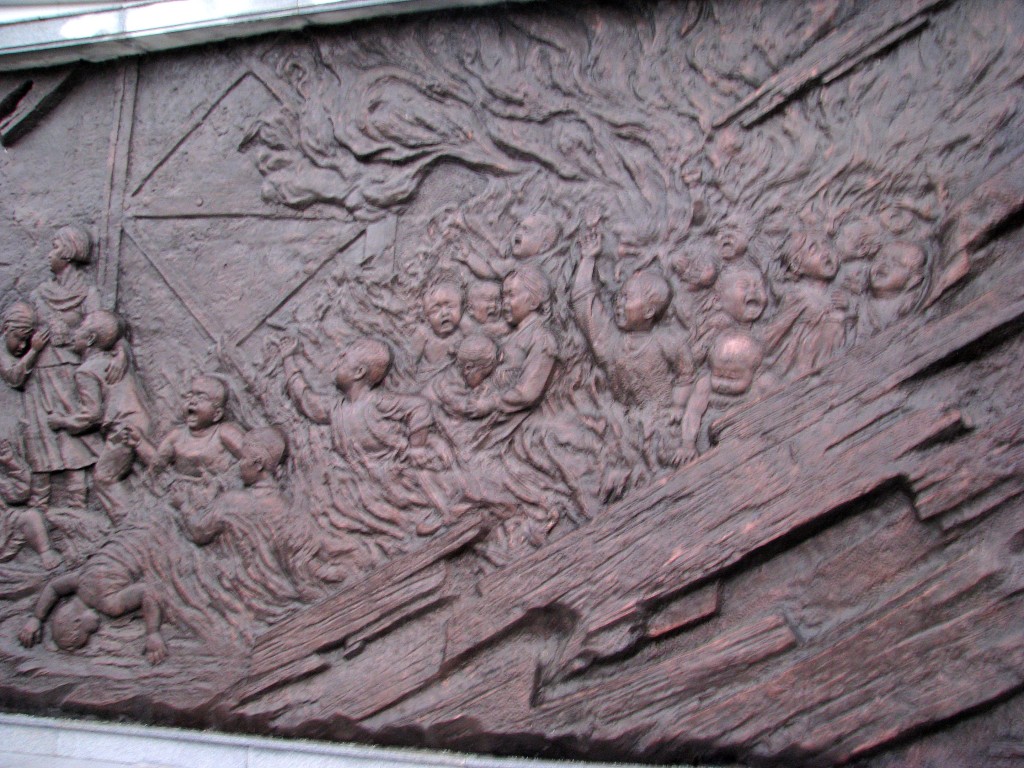
Whether historically accurate or fictional, what distressed me the most was the unsubtle message that this museum transmits to the busloads of school children that are taken through its halls. As a church-related delegation seeking to promote peace in Korea, we spoke a lot not merely about reunification, but more urgently about reconciliation. The Sinchon Museum left me feeling that there was no room left for reconciliation.
As we left, flashlights lit our way through the rain in the direction of our bus. Halfway down the hill, we entered the reconstructed brick granary where our guide said 200 children were burned alive by US soldiers. In the middle of the open space stood a man of short stature. A single fluorescent light high on the vaulted ceiling emphasized the furrows lining his face. He was introduced to us as one of three children who survived that unspeakable event. We were told he was now 70 years old, born in the year Korea was divided.
Before he could begin any prepared speech, our South Korean colleagues engaged him in conversation. Although my interpreter tried to whisper a summary translation into my ear, I was not really listening. It was the face of the survivor that captured my attention. He spoke in a lively fashion, occasionally bursting out in laughter, seemingly at odds with the standards of appropriate behavior conveyed to us.
His job was to tell this story over and over and over again, year after year, to hundreds of thousands of schoolchildren and to tens of thousands of adults, including foreign visitors like me. I saw a man for whom the distinction between fact and faith could not possibly have any meaning. Facts are stories you believe in. Every “fact” portrayed in this museum has been challenged by historians and ideologues alike. But historical factuality is not at issue. In Sinchon, you are meant to subscribe to an article of faith. The one thing I have learned about Juche—notwithstanding its turgid reasoning—is that it tries to capture the Korean soul. It tries to give meaning to Korea’s historical tragedy. How else to honor those who have sacrificed all for Korean self-identity?
The one thing about South Korea that the majority of North Koreans have no problem believing is that South Korea has sold its soul to the archenemy, the United States of America. That’s why the Sinchon Museum has to be in-your-face and graphically brutal. That’s why the single guilty party has to be the Americans. The museum teaches that even when faced with annihilation by the world’s greatest power, patriotic Koreans will continue to be the guardians of the Korean soul.
And that is why South Korean authorities have such an aversion toward their citizens visiting the DPRK. Even though the NCCK delegation had received permission for its journey north, when they returned to Seoul, officials of the Korean Central Intelligence Agency threatened to charge them under the notorious National Security Law for visiting the northern half of the Joint Security Area and the Sinchon Museum without explicit additional authorization.
I came away feeling that reconciliation may well be even more difficult to accomplish than reunification. National reunification—as the DPRK conceives it—could occur while the division of systems remains intact. In contrast, reconciliation requires contact and mutual understanding. It requires open arms and open minds, a willingness to recognize each other’s pain, even when we disagree on its cause. At the very least, it requires that we stop demonizing each other.
——————————————————-
[1] Bowing to images of the dearly departed comes more naturally to a culture imbued with Confucianism and shamanism. There is more psychological resistance to bowing in those of us raised in the cultural ethos of Western Christianity, whose religious heroes are those who refused to bow to anyone or anything other than the one true God. Although I have found many convenient rationalizations for going along with the expectations of my North Korean hosts (who, to be fair, have never insisted on such conformity), I cannot avoid a certain pang of conscience whenever I “pay respect” in this manner. Most of my delegation colleagues admitted feeling the same ambivalence. Some used the brief pause afforded by the act of bowing for quiet meditation, some bowed their heads in silent prayer for those who do not have the benefit of choice, and one told me he prayed that this uncomfortable act might be a tiny contribution to the building of trust and confidence, a stepping stone of solidarity on the road to reconciliation.
Yet the gesture lost significance with repetition, and by the end of the week, the act of “paying respect” became all but meaningless.

